Panasonic Lumix DMC-FZ18
-
-
Written by Gordon Laing
Panasonic Lumix DMC-FZ18 sensor and processing
Panasonic Lumix DMC-FZ18 features continued…
Lenses / Screen and menus / Sensor and processing / anti-shake
The Panasonic Lumix FZ18 is equipped with an 8.1 Megapixel CCD sensor measuring 1/ 2.5in and delivering 4:3 aspect ratio images with a maximum resolution of 3264×2448 pixels. This is a small boost over the 3072×2304 pixel images of its predecessor and should allow for prints to be made about one inch bigger at typical reproductions. The sensor size hasn’t increased though, which could have a detrimental impact on noise levels. See our results and gallery pages to see how it performs in practice.
The FZ18 offers no fewer than four lower resolutions and the choice of two different JPEG compression levels, Fine and Standard. Like its predecessor, the FZ18 impressively features a RAW mode, but now allows you to choose whether you’d like an accompanying JPEG to go with it, whereas the earlier FZ8 always recorded both. The accompanying JPEG on the FZ18 is saved using Standard compression.
It’s great to find a RAW mode in a camera at this price point, and a sensible feature for Panasonic to include when few rivals bother on their non-DSLRs. Panasonic supplies the FZ18 with Silkypix software for basic RAW conversions, or you can use third party programs – the FZ18’s RAW files are supported by Adobe Camera RAW version 4.2 onwards, although this requires Photoshop CS3.
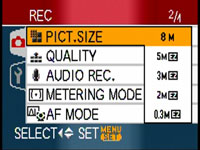 |
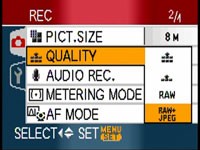 |
The FZ18’s best quality Fine JPEGs typically measure between 3 and 4MB each, while RAW files weigh-in around 13.5MB. There’s 27MB of internal memory to get you started, but like all cameras you should buy a memory card straightaway – like other Panasonics, the FZ18 takes SD memory and is compatible with SDHC cards for higher capacities.
The FZ18 also offers 3:2 and 16:9 aspect ratios, each available in three resolutions. Unlike the cunning sensor of the Lumix TZ3 though, the FZ18 simply crops horizontal bars from the top and bottom of its images to create these wider shapes. In 3:2 mode the maximum image size drops to 3264×2176 pixels, while in 16:9 it falls further to 3264×1840 pixels.
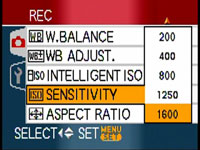 |
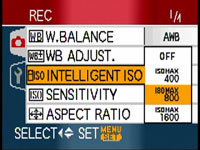 |
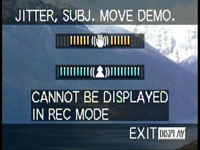 |
Panasonic has slightly increased the FZ18’s maximum sensitivity at full resolution from 1250 to 1600 ISO, although the former setting still remains, and the High Sensitivity preset now operates between 1600 and an optimistic 6400 ISO setting, each at a reduced resolution of 3 Megapixels.
The FZ18’s Intelligent ISO setting may have moved from the mode dial to a menu, but can still detect motion in the frame and automatically increase the sensitivity to provide a sufficiently quick shutter speed to freeze it. In practice this actually works quite well and you can also set an upper limit or 400, 800 or 1600 ISO to maintain reasonable quality. There’s also a neat live demo mode which illustrates the FZ18 distinguishing between motion in the frame and camera shake – see screen.
Panasonic Lumix DMC-FZ18
colour and white balance
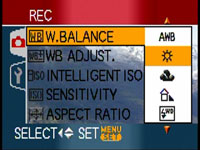 |
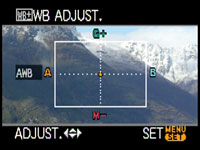 |
The FZ18’s white balance can be set to Automatic, Daylight, Cloudy, Shade, Flash, Halogen or one of two custom presets calculated by taking a reading from a specific subject. You can also manually fine-tune the white balance using a graphical plot.
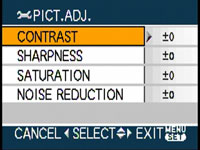 |
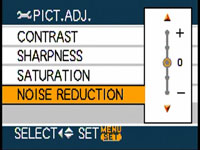 |
Like other Panasonic cameras, the sharpness, contrast, saturation and noise reduction settings can be adjusted using the Pict Adj menu. Unlike the basic Low, Standard and High settings of its predecessor though, the FZ18 now offers five settings for each on a scale of -2 to +2. Zero is selected by default for each, and like the FZ8, this will produce consumer-friendly photos out of the camera, although as you’ll see in our Results and Gallery pages, there’s visible noise even at 100 ISO when images are viewed at 100%.
We repeated our real-life noise tests using the lowest and highest noise reduction settings, although found smearing to be a problem even at the Low setting. This is only really noticeable when viewing images on-screen at 100% though, so while the FZ18 isn’t appropriate for pixel-peepers, its printed output looks fine. At least you also have the option of shooting in RAW and applying third party noise reduction later if desired.
Panasonic Lumix DMC-FZ18 exposure and creative options
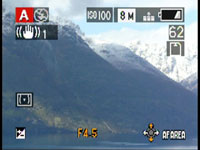 |
The Panasonic Lumix FZ18 offers shutter speeds from 1/2000 to 60 seconds (the longest via its starry sky scene preset) and ten aperture settings with the lens zoomed-out. Aperture and Shutter Priority, along with full Manual modes give you complete access to the settings, providing a decent degree of creative control. In each mode, the joystick on the back is used to select the desired setting and adjust it as required.
Like most non-DSLRs, the choice of apertures reduces at the fastest shutter speeds, and with the FZ18 the full aperture range of f2.8 to f8 is only available up to 1/1000. Increase the shutter to 1/1300 or 1/1600 and the maximum aperture falls to f4.0 and f5.6 respectively, while for the top speed of 1/2000, you’re fixed at f8. In our tests, the FZ18 delivered its sharpest images at f4 or lower.
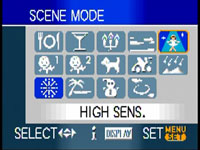 |
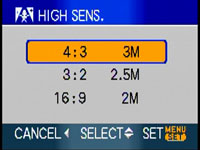 |
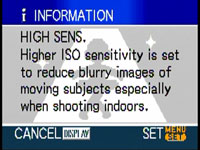 |
For an easier life, the FZ18 also offers a wide array of scene presets: 18 in all, with the four most popular being directly accessible from the mode dial, leaving a further 14 to be selected from a menu. The mode dial offers Portrait, Landscape, Sports and Night Portrait, while the menu offers Food, Party, Candle Light, Sunset, High Sensitivity, Baby 1, Baby 2, Pet, Panning, Starry Sky, Fireworks, Beach, Snow and Aerial Photo.
A neat option that’s new to the FZ18 comes into play when you’ve selected one of the four main scenes from the mode dial. Pressing the menu button allows you to choose variations on that scene, for example under Portrait you’ll find Normal, Soft Skin, Outdoor, Indoor and Creative options. Landscape offers Normal, Nature, Architecture and Creative. Sports offers Normal, Indoor, Outdoor and again Creative.
 |
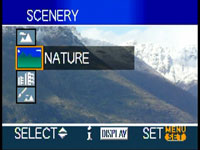 |
Creative appears as an option on all four main scene presets and on Portrait and Night Portrait allows you to adjust the aperture, while on Landscape and Sports you get to directly adjust the shutter speed. The other sub-options also apply relevant settings, for example Architecture overlays the grid for alignment while the various indoor settings adjust the white balance and increase the ISO. Like the Intelligent Auto mode, it’s a clever implementation of using scene presets which presents the relevant options in an intuitive way.
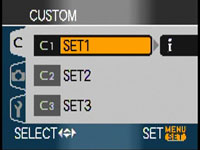 |
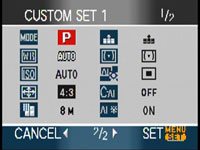 |
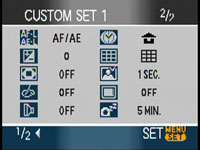 |
Also new to the FZ18 are three Custom presets which can be used to store a wide variety of preferred settings for aspects like mode, quality, white balance, metering, focus and display options.
Panasonic Lumix DMC-FZ18
continuous shooting
The Panasonic Lumix FZ18 offers two burst shooting mode: Normal and Unlimited. This is a change from its predecessor which offered High, Low and Infinity burst modes. Set to Normal, the FZ18 can fire off up to four Fine or seven Normal JPEG images at 3fps. Set to Unlimited, the FZ18 falls to 2fps, but can keep shooting while you have memory remaining. Sadly RAW shooting is not supported in either Burst mode.
To put the FZ18’s Continuous shooting to the test we set it to Normal mode and fired off four Fine JPEGs in 1.3 seconds. Switched to Normal JPEG mode we got seven in 2.3 seconds. Both correspond to 3fps. While the buffer is quite restricted, it’s nice to still shoot at the same rate as most budget DSLRs and allows the FZ18 to capture some reasonable action sequences.
Panasonic Lumix DMC-FZ18
Movie mode
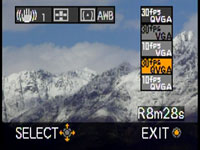 |
With the main mode dial set to the filmstrip icon, the FZ18 can record video clips in the Quicktime Motion JPEG format. The FZ18 can record in conventional 4:3 or widescreen 16:9 aspect ratios and at either 10 or 30fps.
Set to 4:3 the video resolution is either VGA 640×480 pixels or QVGA 320×240 pixels, while at 16:9 the FZ8 records a genuine widescreen WVGA mode of 848×480 pixels. Video recording is not supported on MMC memory cards – you’ll need to use SD cards or the built-in memory. Note if you are using the built-in memory though, the video resolution is fixed at 320×240 pixels.
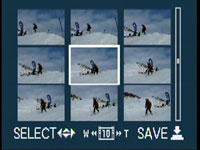 |
Once you start recording, the focus, zoom and aperture value are fixed. Sadly you can’t optically zoom while filming, although optical stabilisation using Mode 1 is available. You’re looking at about 1.36MB per second of high resolution video at 30fps in either 4:3 or 16:9 aspect ratios; the maximum file size for movies is 2GB. The video quality, like other Panasonic cameras, is very good with only a little tearing visible when panning. It’s also nice to switch the TV output aspect ratio to 16:9 and output anamorphic video ready to be stretched out to fill a widescreen TV.
Still photos can be grabbed from movies, and if you like nine separate frames can be saved into a single image to analyse motion – great for perfecting your golf swing or ski jump. The FZ18 also has a flip animation mode which allows you to create movies from a series of stills, lasting up to 20 seconds. The FZ18 also lets you record audio clips as you take normal still photos – each is limited to five seconds of audio.




